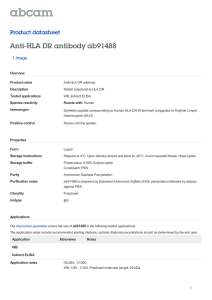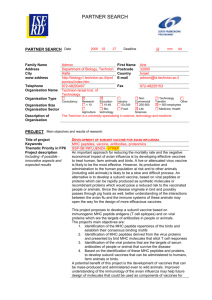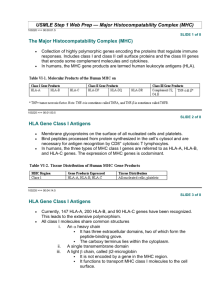Harvard-MIT Division of Health Sciences and Technology
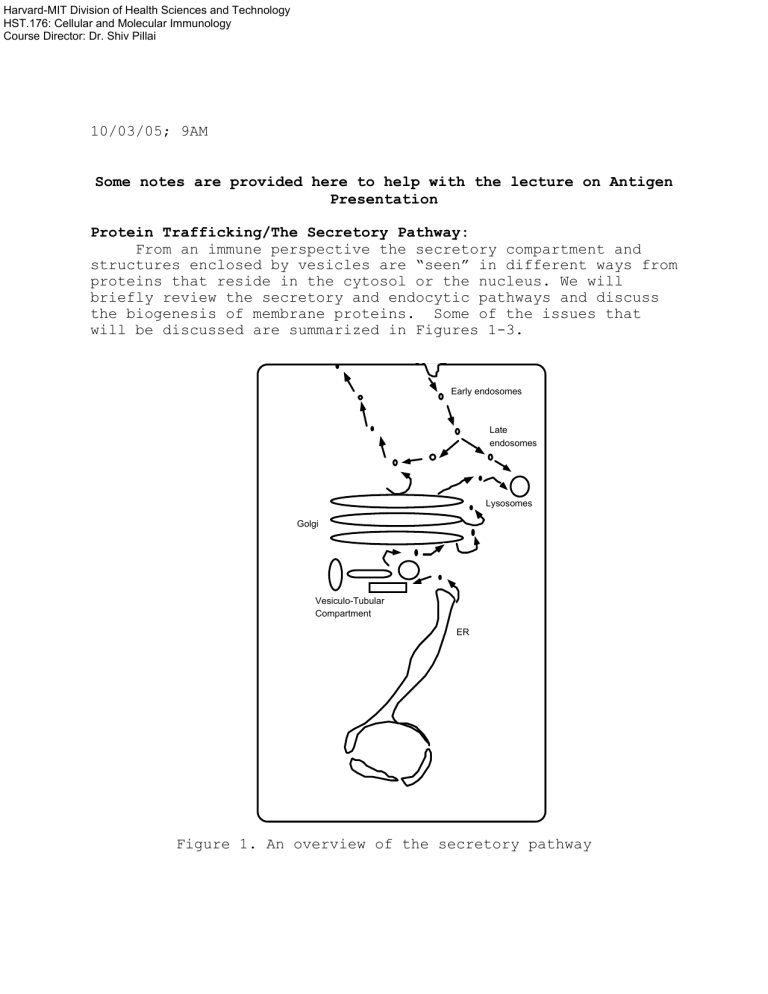
Harvard-MIT Division of Health Sciences and Technology
HST.176: Cellular and Molecular Immunology
Course Director: Dr. Shiv Pillai
1 0/03/05; 9AM
Some notes are provided here to help with the lecture on Antigen
Presentation
Protein Trafficking/The Secretory Pathway:
From an immune perspective the secretory compartment and structures enclosed by vesicles are “seen” in different ways from proteins that reside in the cytosol or the nucleus. We will briefly review the secretory and endocytic pathways and discuss the biogenesis of membrane proteins. Some of the issues that will be discussed are summarized in Figures 1-3.
Early endosomes
Late endosomes
Lysosomes
Golgi
Vesiculo-Tubular
Compartment
ER
Figure 1. An overview of the secretory pathway
Early endosomes
Late endosomes
Multivesicular and multilamellar bodies
Golgi
ER
Proteasomes
Figure 2. Protein degradation occurs mainly in lysosomes and proteasomes
Proteins that enter the cell from the environment are primarily degraded in lysosomes. Most cytosolic and nuclear proteins are degraded in organelles called proteasomes.
Intriguingly these two sites of degradation are each functionally linked to distinct antigen presentation pathways, different kinds of MHC molecules and the activation of different categories of T cells.
Integral membrane proteins maybe inserted into the membrane in a number of ways, the two most common of these ways being considered in Figure 3.
Type I
N
Type II
C
C
N
Cell surface
ER or intracellular vesicles
Type I
N
Type II
C
C
N
Figure 3. The orientation of Type I and Type II membrane proteins.
Antigen presentation pathways
Receptor mediated endocytosis will be discussed briefly in this lecture both in the context of the function of membrane bound immunoglobulins and in the context of antigen presentation pathways.
T cells co-evolved with B cells. They have the ability to look “into” and destroy other host cells if the latter are infected. The basic design of T cell recognition depends on an intrinsic ability to ignore free or soluble antigens. T cell receptors can only recognize antigenic peptides that are appropriately exhibited on cell surfaces. The molecules that bring these peptides to the cell surface, and then exhibit them so that they may be scanned by passing T cells, are known as
Major Histocompatibility Complex (MHC) proteins. These are the most polymorphic proteins known, encoded in most vertebrate species by a very large number of alleles.
The antigen receptor on T cells is made up of two transmembrane polypeptides of the immmunoglobulin superfamily, the T Cell receptor (TCR))
α
and
β
chains. Receptor diversity is generated by the rearrangement, in developing thymocytes, of gene segments that encode these polypeptides. The variable domains of the TCR
α
and
β
chains contribute to the antigen binding site.
TCRs recognize cell surface MHC molecules which are complexed with peptides of either exogenous or endogenous origin. It is now
believed that all TCRs initially generated in the thymus are capable of recognizing MHC like shapes. We will return to this issue when we discuss why a relatively large proportion of T cells in any one individual have the potential to be alloreactive in later lectures on transplantation. The antigen recognizing
TCR
α
and
β
chains associate with proteins of the CD3 complex,
(CD3
γ
,
δ
,
ε
, and
ζ
) which are required for the initiation of signaling from the antigen receptor.
MHC proteins evolved at the same time as B and T cells, to provide a mechanism for T cell receptors to focus exclusively on antigenic fragments that are held on the cell surface. Since T cell receptors recognize only MHC-peptide complexes, free viruses or viral antigens are totally ignored by T lymphocytes. Although the physiological function of MHC molecules relates to antigen recognition by T cells, they acquired their name because they were discovered in the context of transplant rejection. They were originally referred to as Major Histocompatibility Complex
Antigens because they were identified as the most prominent antigens involved in experimental graft rejection. Elegant genetic studies, which helped create the field of immunogenetics, established that these antigens map to a single chromosome in the mouse, to a set of genes that came to be known as the H-2 locus.
The corresponding locus in man is on chromosome 6 and is referred to as the Human Leukocyte Antigen or HLA locus. MHC molecules in man are called HLA molecules and the terms MHC and HLA will be used interchangeably. HLA molecules are found on leukocytes but their expression is not restricted to white cells. MHC class I molecules are expressed on all nucleated cells and are recognized by T cell receptors on cytotoxic or CD8
+
T cells (Cytotoxic T
Lymphocytes or CTLs). They generally present peptides derived from proteins synthesized “endogenously” in the cell expressing the MHC class I molecule of interest. MHC class II molecules are primarily expressed on B cells and other professional antigen presenting cells (mainly macrophages and dendritic cells). Their expression may be induced on endothelial and epithelial cells exposed to cytokines such as
γ
-interferon. MHC class II molecules generally present peptides derived from exogenous proteins which must be internalized by the antigen presenting cell. These proteins are broken down or “processed” into peptides intracellularly. MHC class II-peptide complexes are recognized by antigen receptors on helper or CD4
+
T cells.
The structure of MHC proteins
MHC molecules are cell surface glycoproteins which contain two membrane-proximal immunoglobulin like domains as well as two more distal specialized domains which together form a peptide binding groove embedded between two
α
-helical ridges. MHC class
I molecules are made up of two polypeptide chains and a tightly associated peptide moiety (Figure 4). The MHC class I heavy chain
is a transmembrane glycoprotein of about 40-45 kDa which associates tightly with a small non-anchored 12 kDa immunoglobulin superfamily protein known as
β
2 microglobulin. MHC class II molecules are heterodimers which consist of an
α
and a
β chain, both of which are transmembrane glycoproteins (Figure 5).
Our current understanding of MHC function owes a lot to the knowledge of the structure of MHC molecules obtained by X-ray crystallography. Crystal structures are available for a range of
HLA class I and class II molecules complexed with specific peptides and also, more recently for HLA class I -peptide -T cell receptor complexes. The MHC class I heavy chain is made up of three domains. The
α
1 and
α
2 domains combine to contribute to two
α
-helical ridges which surround a long, narrow, groove whose floor has a
β
-pleated structure. This groove is where specific peptides are snugly bound and presented to appropriate T cell receptors. The surface contains distinct crevices into which specific side-chains of a highly specific peptide may fit.
Peptides that are presented by MHC class I molecules are usually peptide
α
2
α
1
Heavy chain
α
3
β
2-microglobulin
Transmembrane domain
8 or 9 amino acids in length. For a particular MHC class I molecule, the specific crevices in the groove dictate that certain invariant amino acid side-chains must be present in peptides that bind specifically to it. These residues on the peptide are referred to as anchor residues since they are critical for the tight binding of a set of peptides to individual class I heavy chains
Figure 4. A schematic view of an MHC class I molecule.
The
α
3 domain of the MHC class I heavy chain has a typical immunoglobulin fold structure, consisting of a
β
sandwich where adjacent
β
sheets are held together by a disulfide bridge. This domain interacts with
β
2 microglobulin, a non-anchored protein which also has a similar immunoglobulin domain like structure.
The
α
3 domain is also involved in the interaction of MHC class-I molecules with the CD8 molecule on cytotoxic T cells.
The antigen binding groove on MHC class II molecules broadly resembles that found in MHC class I molecules. This groove is contributed to by the
α
1 domain of the
α
chain and the
β
1 domain of the
β
chain. The MHC class I groove is approximately 25A
°
long and is closed at both ends; it can therefore only accommodate relatively short peptides. The MHC class II groove is open-ended and can accommodate larger peptides. Non-polymorphic portions of the
α
2 and
β
2 immunoglobulin like domains contribute to the interaction with CD4 on T cells. peptide
α
1
β
1
α
2
β
2
Figure 5. A schematic view of an MHC class II molecule
The MHC class I pathway
MHC class I molecules are designed to complete their folding and assembly processes in the endoplasmic reticulum (ER). Egress from the ER and subsequent transport to the cell surface requires that the complete trimolecular complex of heavy chain,
β
2 microglobulin, and peptide be properly assembled (Figure 6). The
MHC class I heavy chain is translocated into the ER by a classic
signal peptide dependent mechanism through the Sec 61 channel.
Sec61 is an ER protein whose subunits form a channel through which polypeptide chains that contain signal peptides are translocated into the ER. The MHC class I heavy chain protein is anchored in the ER membrane and folds partially in conjunction with a resident transmembrane ER chaperone known as calnexin. In this compartment it associates with the
β
2 microglobulin component, which is also translocated into the lumen of the ER in a signal-peptide dependent manner.
β
2-microglobulin is not an integral membrane protein; it is initially translocated into the lumen of the ER, and can be secreted. The heavy chain-
β
2 microglobulin heterodimer remains associated in a complex with a protein known as tapaisin until it receives a peptide which is either 8 or 9 amino acids in length and which can fit into its specific groove. A growing number of N-terminal aminopeptidases that include but are not limited to Leucine Aminopeptidase (LAP) and ER aminopeptidase I (ERAP1) appear to participate in the Nterminal trimming of peptides so that they can optimally fit in the groove. Tapaisin forms a bridge between MHC class I molecules and the TAP (Transporter associated with Antigen Processing) heterodimers which pump peptides into the ER from the cytosol.
The TAP transporter is a pump made up of two transmembrane
ATPases, TAP1 and TAP2, that form a peptide-translocation channel in the ER membrane. TAP1 and TAP2 are encoded by genes that are a part of the MHC complex (discussed below).
β
2-microglobulin
MHC class I heavy chain
Calnexin
Tapaisin
TAP
Proteasome
Figure 6. An outline of the MHC class I pathway.
Cellular proteins which lack signal peptides are generally destined for the cytosol and the nucleus. Most of these proteins are degraded in the cytosol in proteasomes. As a prelude to being degraded in proteasomes, many proteins are covalently tagged in the cell with tandem repeats of a peptide known as ubiquitin.
Proteasomes are highly organized cylindrical protein-degradation machines made up of 4 circular segments of 7
α
, 7
β
, 7
β,
and 7
α protein subunits respectively, which together make up the 20S proteasome. The 20S proteasome core contains a number of proteolytic activities. At either end of the core is a “cap” structure which combines with the 20S proteasome to generate the
26S proteasome. The cap contains proteins that can contribute to the unfolding and deubiquitination of target proteins. Three subunits of the proteasome, LMP-2, LMP-7, and MECL-1 may be induced by interferon-
γ
. LMP-2 and LMP-7, like TAP-1 and TAP-2, are encoded within the class II region of the HLA complex on chromosome 6.
Although proteins that are targeted to proteasomes are primarily cytosolic or nuclear polypeptides, proteins retained within the ER as well as cleaved signal peptides may be
translocated out of the ER lumen via the Sec 61 channel.
Translocated proteins are ubiquitinated and targeted for proteasomal degradation. Proteins from the secretory pathway, including misfolded ER retained MHC molecules, may also therefore be targeted to the cytosol and to the MHC class I antigen presentation pathway.
The MHC class II pathway
Unlike the MHC class I pathway which is designed to eventually present cytosolically derived peptides to CD8 cytotoxic T cells, the MHC class II pathway is explicitly designed to present peptides derived from proteins that are sampled from the environment by professional antigen presenting cells. Even though MHC class II molecules are synthesized on ER bound ribosomes and assemble initially in the ER, they are designed NOT to sample peptides in the ER lumen itself (these peptides must be presented by MHC class I molecules). The
α
and
β chains of MHC class II molecules assemble in the ER membrane and associate immediately with a third component known as the invariant chain (Ii). The invariant chain is a Type II transmembrane protein (in Type II proteins the carboxy-terminus protrudes into the lumen of the ER whereas in Type I proteins the
N-terminus is exposed to the lumen). The C-terminus of the invariant chain folds into and occludes the antigen binding groove of the MHC class II molecule. Occupancy of the peptidebinding groove by the invariant chain prevents endogenous peptides that enter the ER from occupying the groove. This permits the efficient loading of MHC class II grooves with exogenously derived peptides in a post-Golgi compartment. The N terminus of Ii protrudes into the cytosol and provides targeting signals to direct (
αβ
Ii)
3 nonamers through the Golgi stacks to a specialized acidic late endosomal/lysosomal compartment known as the MIIc compartment. The invariant chain is proteolytically cleaved to yield a peptide called CLIP which remains tightly bound to the MHC class II groove.
Figure 7. An overview of the MHC class II pathway
Proteins from outside the cell are sampled and internalized by endocytic receptors on the antigen presenting cell. In the case of a B lymphocyte the antigen receptor functions as the endocytic receptor as shown in Figure 7.
HELPER T CELL
CD4
T cell receptor
Peptide -CLIP exchange mediated by HLA-DM
CLIP protein antigen membrane immunoglobulin
Invariant chain
MHC class II
Nucleus
Endoplasmic reticulum
Internalized proteins are cleaved into peptides by proteases such as cathepsin-L and cathepsin-S. A distinct type of HLA molecule, a heterodimer known as HLA-DM, performs a unique function in the MIIc compartment. This molecule serves as a peptide -exchanger, displacing CLIP from the MHC groove and permitting exogenously derived peptides to slide into the groove.
MHC class II- peptide complexes are then transported to the cell surface. In general, peptides that bind the class II groove tend to be longer than those that bind to the corresponding groove in class I molecules - the average length of MHC class II binding peptides ranges from 14 to 18 amino acids, but since peptides can spill out of both ends of the non-occluded MHC class II groove they can even be considerably longer.
Summary
Proteins that contain hydrophobic N-terminal or internal signal or leader peptides are co-translationally or posttranslationally translocated into the endoplasmic reticulum.
These proteins may either reside within the secretory pathway, may be destined for lysosomes or may be transported to the cell surface by vesicular transport.
The Major Histocompatibility Complex Antigens were initially identified as prominent antigens involved in graft rejection. The murine MHC locus is called the H-2 complex.
The syntenic human chromosomal region is called the Human
Leukocyte Antigen (HLA) locus.
T-cell recognition of antigen requires that antigenic peptides be displayed within the cleft of a self-MHC molecule at the cell surface. This requirement is called self-MHC restriction. CD4
+
helper T cells are class II MHC restricted, and CD8
+
cytotoxic T cells are class I MHC restricted.
MHC Class I proteins are expressed on all nucleated cells and present antigenic peptides derived endogenously within the cell. Endogenous antigens are degraded into peptides within the cytosol by the proteasome (containing several peptidase activities). The resulting antigenic peptides are transported into the lumen of the rough endoplasmic reticulum (RER) by TAP, an ATP-dependent peptide translocator. MHC Class I proteins consist of two subunits: the membrane-anchored heavy chain protein and the soluble
β
2-microglobulin (
β
2M) protein. The protein tapaisin forms a bridge between MHC I and TAP and aids in the formation of the MHC-peptide complex. Once peptide is bound, the MHC complex is stable and moves from the RER through the Golgi out to the plasma membrane.
MHC Class II proteins are expressed by B cells and other professional antigen presenting cells (i.e., macrophages and dendritic cells) and present exogenous peptides. Exogenous antigens, internalized by phagocytosis or endocytosis, are degraded by various hydrolytic enzymes within lysosomes. In
the ER, newly synthesized and translocated MHC Class II molecules associate with the invariant chain, which blocks binding of cellular peptides. The MHC II molecules then move through the Golgi into endocytic vesicles, where the invariant chain is degraded by proteases, leaving the CLIP fragment bound to the MHC. As the MHC-CLIP moves to lowerpH compartments, antigenic peptides displace CLIP. The MHCpeptide complex then moves to the plasma membrane.
Objectives/Study questions
1. What is the secretory pathway? What is a signal or a leader peptide?
2. What are the major sites of protein degradation in the cell?
3. What is receptor mediated endocytosis?
4. Trace the path of a newly synthesized immunoglobulin heavy chain protein of the membrane form, from the initiation of translation to the cell surface. Is the pathway by which this protein makes its way to the cell surface the same route taken by an MHC class II
α
or
β
chain? Explain.
5. Describe the MHC Class I pathway.
6. What role does the invariant chain play during antigen pesentation?



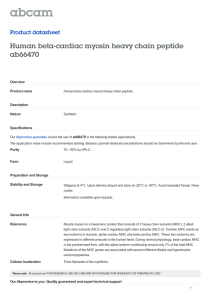

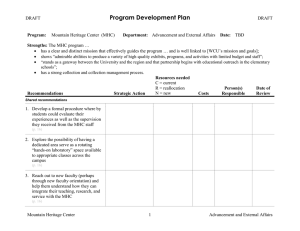
![Anti-HLA-DQA1 antibody [HI118] (PerCP) ab91329 Product datasheet Overview Product name](http://s2.studylib.net/store/data/012448198_1-1438860d79d2655f551f9001711a64ba-300x300.png)
